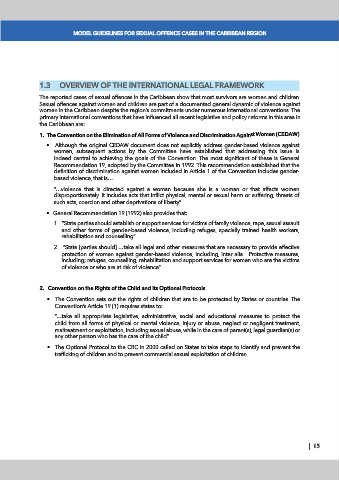Page 614 - Magistrates Conference 2019
P. 614
MODEL GUIDELINES FOR SEXUAL OFFENCE CASES IN THE CARIBBEAN REGION
1.3 OVERVIEW OF THE INTERNATIONAL LEGAL FRAMEWORK
The reported cases of sexual offences in the Caribbean show that most survivors are women and children.
Sexual offences against women and children are part of a documented general dynamic of violence against
women in the Caribbean despite the region’s commitments under numerous international conventions. The
primary international conventions that have influenced all recent legislative and policy reforms in this area in
the Caribbean are:
1. The Convention on the Elimination of All Forms of Violence and Discrimination Against Women (CEDAW)
• Although the original CEDAW document does not explicitly address gender-based violence against
women, subsequent actions by the Committee have established that addressing this issue is
indeed central to achieving the goals of the Convention. The most significant of these is General
Recommendation 19, adopted by the Committee in 1992. This recommendation established that the
definition of discrimination against women included in Article 1 of the Convention includes gender-
based violence, that is…
“…violence that is directed against a woman because she is a woman or that affects women
disproportionately. It includes acts that inflict physical, mental or sexual harm or suffering, threats of
such acts, coercion and other deprivations of liberty”.
• General Recommendation 19 (1992) also provides that:
1. “State parties should establish or support services for victims of family violence, rape, sexual assault
and other forms of gender-based violence, including refuges, specially trained health workers,
rehabilitation and counselling”
2. “State [parties should] …take all legal and other measures that are necessary to provide effective
protection of women against gender-based violence, including, inter alia... Protective measures,
including; refuges, counselling, rehabilitation and support services for women who are the victims
of violence or who are at risk of violence”.
2. Convention on the Rights of the Child and its Optional Protocols
• The Convention sets out the rights of children that are to be protected by States or countries. The
Convention’s Article 19 (1) requires states to:
“…take all appropriate legislative, administrative, social and educational measures to protect the
child from all forms of physical or mental violence, injury or abuse, neglect or negligent treatment,
maltreatment or exploitation, including sexual abuse, while in the care of parent(s), legal guardian(s) or
any other person who has the care of the child”.
• The Optional Protocol to the CRC in 2000 called on States to take steps to identify and prevent the
trafficking of children and to prevent commercial sexual exploitation of children.
| 15

